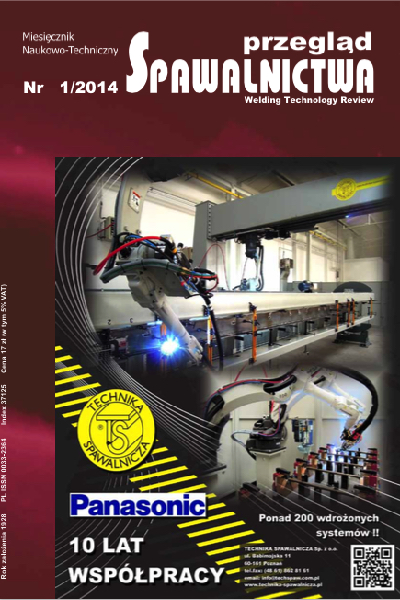Rozkład naprężeń w krzyżowym złączu spawanym z uwzględnieniem rzeczywistego kształtu spoiny
Main Article Content
Abstract
Złącza spawane ze względu na niejednorodność właściwości mechanicznych, strukturalnych oraz kształtu spoiny są w konstrukcji miejscem powodującym spiętrzanie naprężeń. najczęściej w obliczeniach przyjmuje się, że kształt spoiny jest jednakowy na całej długości, a zarys nie odbiega od teoretycznego. W artykule przedstawiono rozkład naprężeń w spoinie wykonanej na próbkach stalowych (S355J2+N), której kształt przeniesiono do analizy metodą elementów skończonych przez skanowanie 3D. Uzyskane wyniki porównano z wynikami dla spoiny o promieniu zaokrąglenia linii wtopienia równym 1 mm.
Stress distribution in cross welded joint taking into account the real shape of weld
aô°€ô°‚tract
Welded joints due to their nonhomogeneous mechanical, structural and geometrical properties are the reason for stress concentration in the construction. Generally in the calculation it is assumed that the shape of the weld is uniform over the entire length, and the outline does not deviate from the theoretical one. This article shows the distribution of stress in the weld performed on specimens made of S355J2+N steel, the shape of which was transferred to the finite element analysis by application of 3D scanning. The results were compared with those obtained from the model of the weld with welding toe equal to 1 mm.
Downloads
Article Details
Creative Commons CC BY 4.0 https://creativecommons.org/licenses/by/4.0/
Welding Technology Review (WTR) articles are published open access under a CC BY licence (Creative Commons Attribution 4.0 International licence). The CC BY licence is the most open licence available and considered the industry 'gold standard' for open access; it is also preferred by many funders. This licence allows readers to copy and redistribute the material in any medium or format, and to alter, transform, or build upon the material, including for commercial use, providing the original author is credited.
References
Blacha Ł., Karolczuk A., Bański R., Stasiuk P.: Eksperymentalna analiza trwałości zmęczeniowej krzyżowych złączy spawanych w odniesieniu do wielkości elementu. Acta Mechanica et Automatica, vol. 5, s. 16÷20, Białystok 2011.
Hobbacher A.: Recommendations for fatigue design of welded joint and components, IIW document IIW-1823-07 ex XIII-2151r4-07/XV-1254r4-07, Paris 2008.
Kaffenberger M., Malikoutsakis M., Savaidis G., Vormwald M.: Fatigue resistance of weld ends. Computational Materials Science, 52(2012), s. 287÷292.
Blacha Ł., Karolczuk A., Łagoda T.: Modeling of stress in welded joints under consideration of plastic strains in fatigue life calculations. Materials Testing, vol. 53, s. 339÷343, Monachium 2011.
Hou C-Y.:.Fatigue analysis of welded joints with the aid of real three-dimensional weld toe geometry. International Journal of Fatigue, 29(2007), s. 772÷785.
Stewart W.J.: Probability, Markov Chains, Queues, and Simulation. The Mathematical Basis of Performance Modeling. Princeton University Press. s. 105. Princeton 2011.
Karolczuk A., Blacha Ł.: Koncepcja najsłabszego ogniwa w modelowaniu trwałości zmęczeniowej złączy spawanych. Acta Mechanica et Automatica, vol. 5, s. 51÷54, Białystok 2011.
